There is no house or apartment without a kitchen. This room is playing important role In human life. is designed in such a way that its many functionalities are also beautiful appearance. The main task is to separate the working area of the kitchen from the dining room.
Zoning the kitchen with a table with a partition
That is why zoning the kitchen and living room is the most important issue when building a living space.
Of course, designers and architects have been dealing with this issue for a long time. They have developed numerous options for kitchen zoning, allowing you to achieve maximum efficiency from the kitchen space.
Zoning with furniture
Separation kitchen space done using a wide variety of furniture. For example, you can install a table that will separate the dining room from the kitchen space. The idea of dividing furniture depends on the existing one. It is divided into several forms.
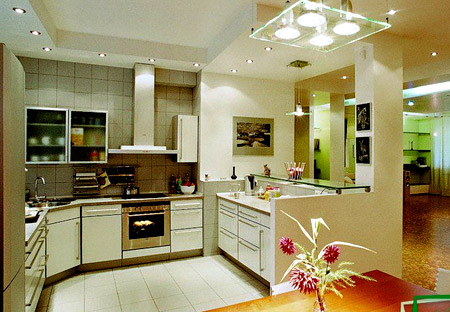
An example of zoning a kitchen with a dining counter
Corner
For this design, two walls forming a certain angle are considered best.
U-shaped
Kitchen equipment and working surface, according to the design, is installed along the length of three walls. The exit is located on the fourth wall.
Ostrovnaya
With this design, the tabletop is placed in the middle of the room. Install near the walls:
- Kitchen equipment;
- Furniture;
- Decorating elements.
Linear
According to the design, the furniture is arranged only along one wall.
Other zoning methods
To perform a wide variety of designs. In many apartments, plaster partitions separate the dining room from the kitchen.
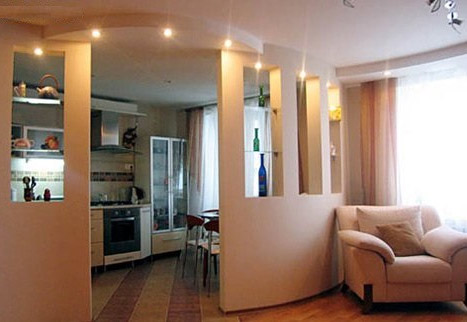
Option for zoning the kitchen with plasterboard partitions
To prevent the work area from touching the dining room, it is installed on a podium. The result is a visual effect of separating the dining room from the kitchen.
When it has small dimensions, an arch is considered a very good option. will remain the same, but its appearance will become much more attractive.
Playing with colors
Today, choosing the color of a kitchen is quite easy. In this matter, the design of the room plays a very important role, as well as the individual preferences of the kitchen owners. You can choose plain wallpaper or create contrasting transitions. IN last years Vinyl washable wallpaper used to cover kitchen walls is very popular.
Lighting
The kitchen should always be light. In addition to the usual light bulbs that illuminate the common space, it is worthwhile to provide additional lighting. If the kitchen has high ceilings, you can install additional pendant lights.
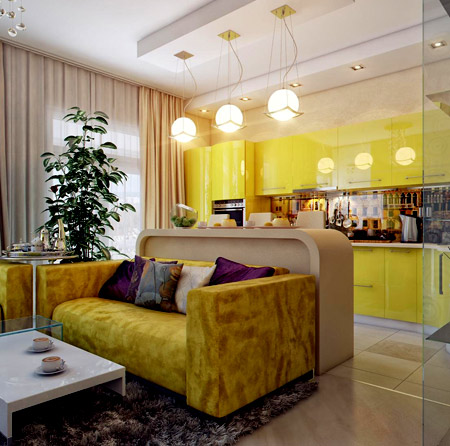
An original version of decor and zoning of the kitchen with lighting
For low ceilings, overhead lamps are installed.
For example, the work area should have the most intense lighting, since this is where food is prepared. You can create diffused light in the dining room.
The idea of installing a ceiling lamp with adjustable height pendants. It is hung directly in the middle of the kitchen to illuminate the dining table. In addition, the tabletop can be illuminated in another way. Mounted above hanging drawers LED Strip Light. If the drawers have glass doors, you can install spotlights in them.
Ceilings
Multi-level ceilings are eye-catching. They harmonize with the corresponding floor design. To finish the ceiling in the kitchen, a variety of materials are used:
- Styrofoam;
- washable wallpaper;
- drywall.
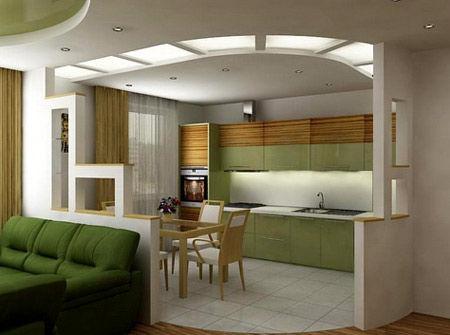
This is what a multi-level plasterboard ceiling looks like
In most cases, multi-level ceilings are made of plasterboard.
Various architectural transitions are decorated with built-in lamps and spotlights.
Finishing materials
To emphasize different areas of the kitchen space, all kinds of finishing materials are used. Thanks to this, visualization of the division of zone space is achieved. For example, the area where food is prepared can be lined with tiles, decorate the dining room with wallpaper in warm colors.
Bar counter
This zoning element has achieved great popularity. The bar counter is in demand when developing the design of original studio apartments. In some cases, the bar counter plays the role of a dining table. This option is mainly used by young people. Sometimes the bar counter becomes part of the furniture. It looks harmonious with arches and various columns.
In principle, the bar counter is not exactly a home item, but it has an aesthetic function. With its help, excellent zoning of the kitchen occurs, because the bar counter becomes an extension of the work space.
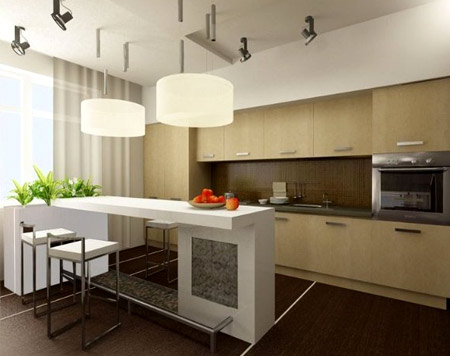
An example of kitchen zoning using a bar counter
IN small families the counter can become a dining table and save a lot of space. In the designer's designs, the bar counter turns into an interior or furniture detail.
Combined options
When the area of the apartment is small, using various combinations of zoning, you can combine several rooms at once and get one large one.
Kitchen-living room
This design technique, when the kitchen is combined with the living room, has become very popular in recent years. The function of a guest room is performed by a small sofa located near the dining table. In such a kitchen, in addition to preparing food, guests are greeted.
Kitchen as a place to work
With the help of transformable furniture, you can zone the kitchen space together with the work space. The dining table can become a workplace, and the necessary documentation can be stored on hanging shelves. 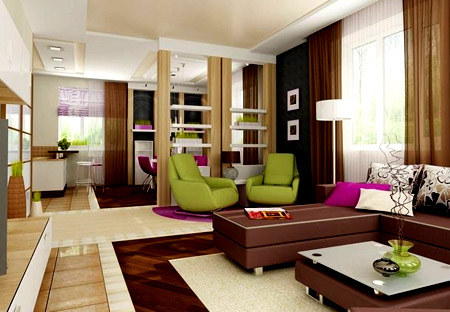
Kitchen-dining room
This is a standard option when the kitchen combines several functions at the same time. To make such a design project look beautiful and attractive, use:
- podiums;
- arches
Thanks to such details, a visual separation of the kitchen from the dining room is achieved. In principle, in the kitchen you can use the most different variants zoning. The combination of color and lighting effects looks beautiful. It is very important to use original accessories that can become the highlight of the kitchen.
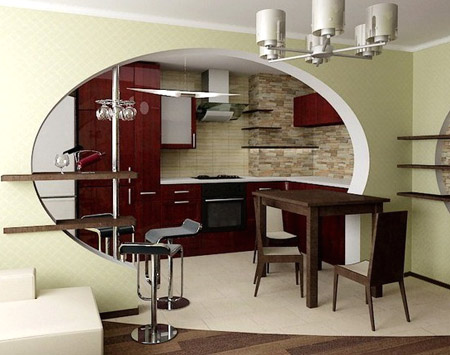
Zoning option for kitchen-dining room
Ergonomics
Of course, kitchen zoning is done according to individual needs, however, you must always remember about safety precautions and ergonomic issues. Any kitchen has several main zones:
- Washing;
- Cooking food;
- Food storage.
According to the rules of ergonomics, each such zone should be located at the top of the “work triangle”. The distance between zones must exceed 60 cm.
Washing
In this square the best option is considered to be the installation of a sink, near which you need to install a dishwasher. It is good to install a dryer directly above the sink.
The free space under the sink can be occupied by a container where waste is stored. Since the water in the tap is not always of the proper quality, a water filter and a grinder are installed directly under the sink. It is desirable that the sink has large dimensions and appropriate depth.
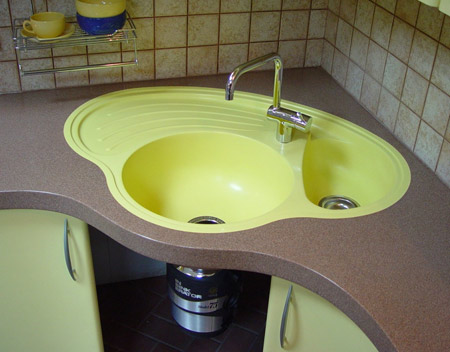
Original design of sink and sink in the kitchen
For washing, a faucet with a flexible tap and a large height is considered ideal. Today you can purchase a variety of additional accessories for the kitchen. Since there is Dishwasher, then there is no need to install a second sink. The most the best option is considered a one-piece sink that is compatible with the countertop.
Cooking department
The main place of such a zone is considered to be the hob. It is divided into gas and electric. When using gas, the kitchen area must be separated by a partition. To combine the kitchen with the living room, you must install sliding partitions. Such requirements are imposed by the fire inspectorate.
The hob installed in the center of the kitchen looks original. However, this option is acceptable only in a kitchen with large dimensions.
Storage department
To store kitchen utensils, requires a lot of free space. Therefore, it is recommended to hide all technical devices in cabinets. The freed up space will help arrange a storage area. If the kitchen has a small area, you can install the top drawers in two tiers, right up to the ceiling.
Today, many owners install a vertical oven, installing it at eye height. Drawers where pans are stored are located under the hob. Drawers are always much more convenient than cabinets: you don’t have to bend over to find the thing you need.
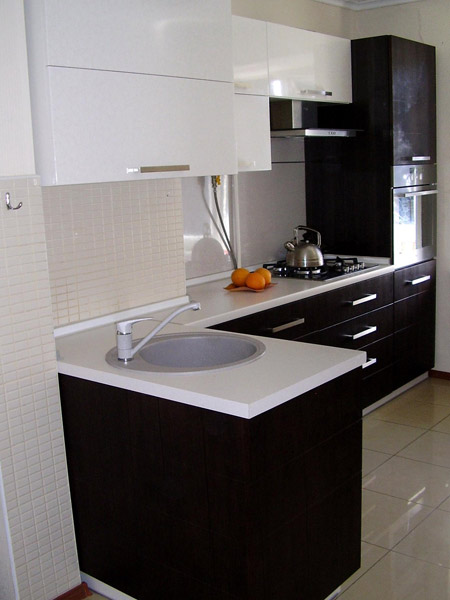
Kitchen decor and interior in minimalist style
To free up space, experts recommend turning all appliances, including the refrigerator, into speakers. This will free up a lot of additional free space where you can mount shelves to store accessories. As a result, the kitchen will become more spacious and more convenient for cooking.
Among all the options for combining rooms, the kitchen-dining room has probably become the most popular due to its functionality and convenience. This layout is used both in small apartments, and in spacious houses and cottages.
Advantages of a combined kitchen-dining room
The combined room optimally corresponds to the tradition of combining eating with relaxation and communication. Family dinners and tea parties in front of the TV, coffee with friends and lunch for guests - for all these events, a kitchen combined with a dining room is much more suitable than separate rooms. An ordinary kitchen is too cramped, and the hall, living room or dining room, located at a distance, force the owners of the house to endlessly run along the corridor with cups, trays and plates.
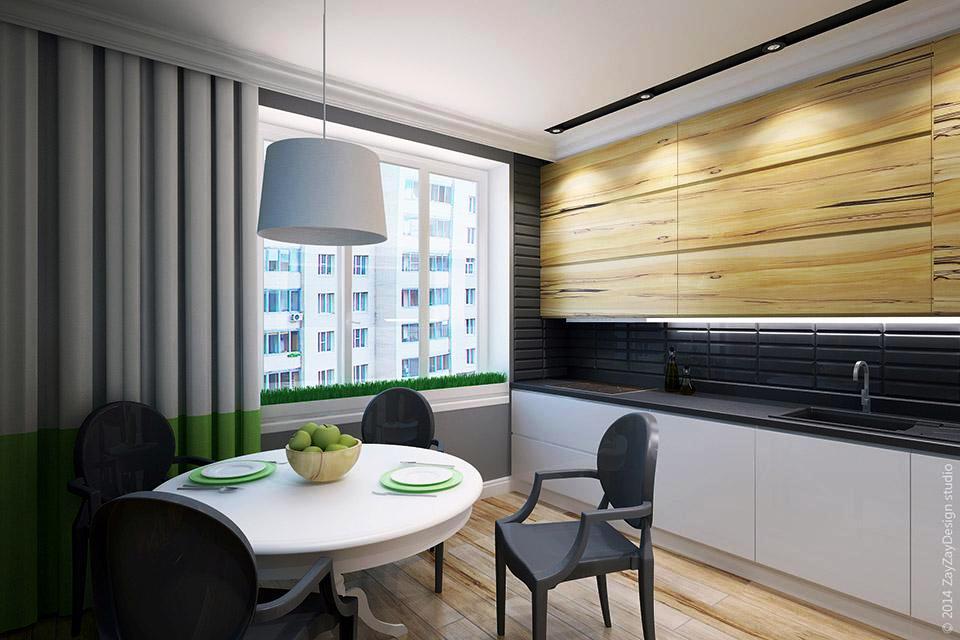
Transforming two rooms into one also has an economic effect - now one dining table, one TV, one set of chairs is enough for them. IN otherwise they would have to be bought in double quantity or make do with inappropriate furniture, for example, use a coffee table, sofa and armchairs in the living room, which is not always convenient.
Unifying space
The layout of the dining room-kitchen is, on the one hand, a combination of two rooms, and on the other, a delimitation of the resulting expanded space, dividing it into functional areas.
Consolidation in the literal sense of the word is not always necessary in a house or cottage, in which a large room is often provided for at the design stage. It is usually required in standard apartments, where, through redevelopment, the kitchen is combined with the adjacent room.
Complete removal of the dividing wall allows you to get a spacious room that gives a minimum of restrictions in terms of the location of the main elements. It is in such rooms that you can place an island work area.
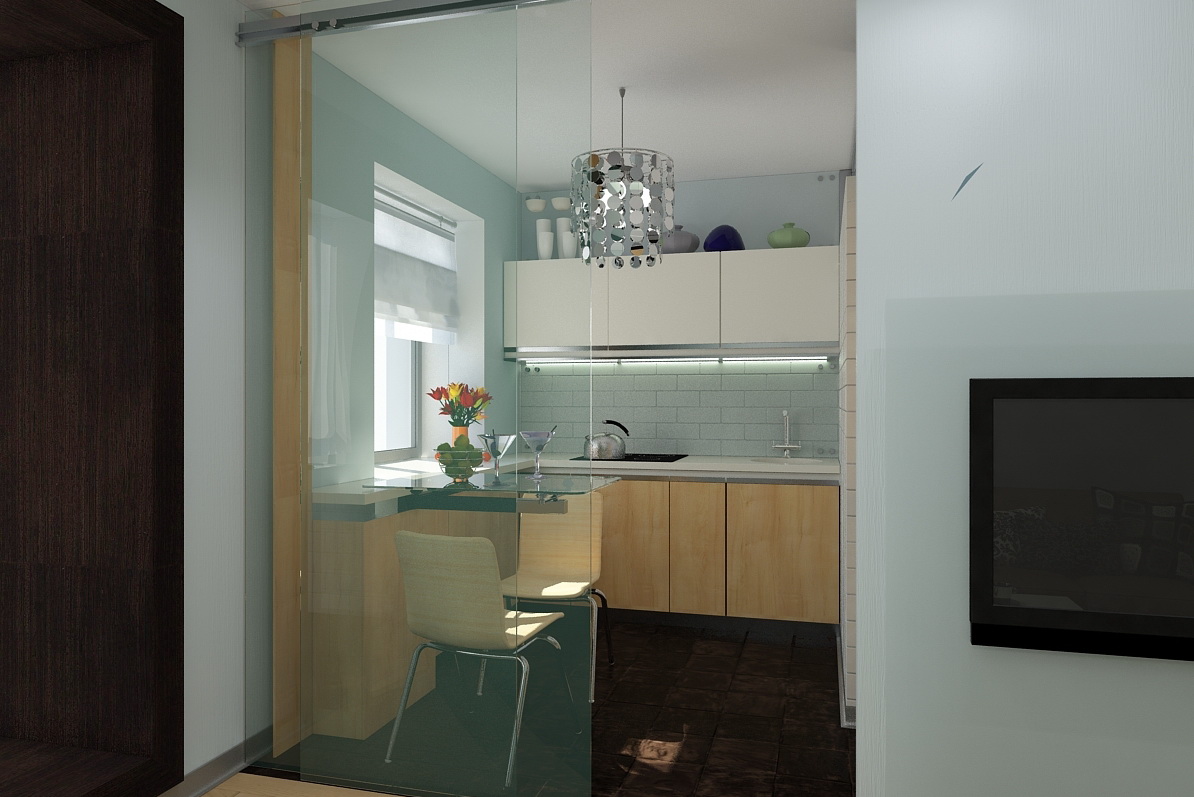
Installing a sliding partition allows, if necessary, to separate functional areas not only visually, but also physically. The kitchen-dining room project may involve the complete replacement of a load-bearing wall with a partition or the connection of rooms with an arched opening equipped with a roll-out or folding structure. Such a passage can be the size of a regular interior door or be much wider.
Layout types
There are several classic ways to place a working and dining area
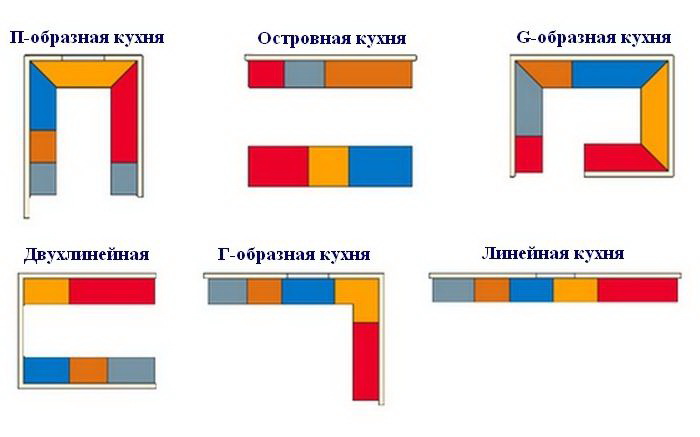
Island and peninsular layouts
Island layout is optimal for large area and provides for a central location of the work sector. Variable execution – peninsular layout, joining one of the walls, but at the same time protruding into the general space. Before choosing this type of arrangement, it is important to evaluate the ratio total area premises and the expected area of the working area. It is important that such an “island” does not clutter up the space, either visually or actually, leaving enough space for comfortable relaxation.
Corner location
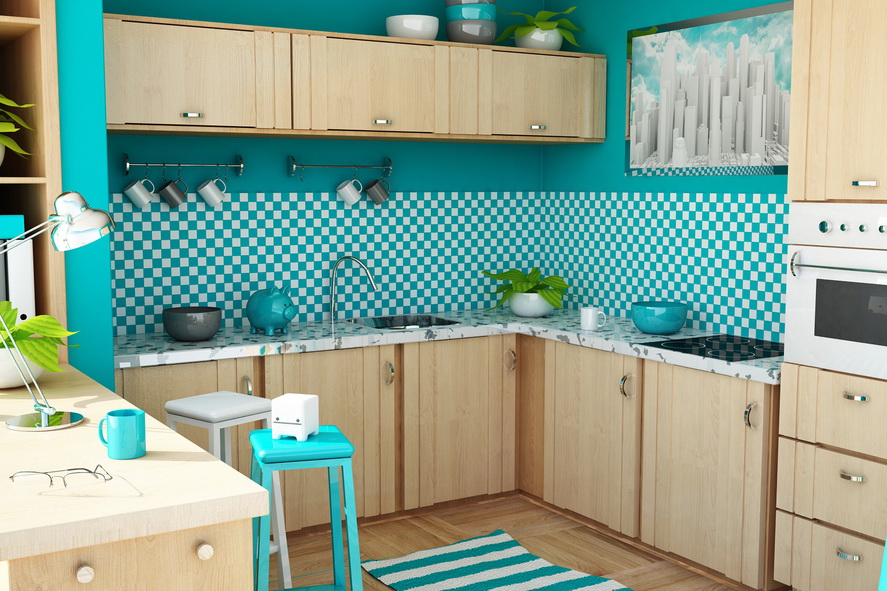
The L-shaped layout can be considered universal. It ideally forms a work triangle due to the fact that household appliances and shelves with dishes are located close to each other along perpendicular walls. The only limitation for using an L-shaped layout may be a situation when the combined kitchen and dining room become a narrow and long room.
Single-row placement of the working area
The linear arrangement of the work area elements in one row allows you to allocate maximum space for the relaxation area. A room with this layout forms a kitchen-dining-living room, in which you can not only dine, but also watch TV and read. For single-row placement it is convenient to replace the classic kitchen set a compact “mini” model, characterized by the ergonomic arrangement of all functional elements in a small space.
Combined schemes
The planning methods listed above are basic. They can be used in pure form"or create convenient and original combinations. For example, a kitchen-dining room with a corner cooking area can be equipped with a table located perpendicularly, if the room is not too long and the dimensions of the table do not interfere with free passage.
Zoning the kitchen-dining room
To separate the dining and working areas, they are used various ways. The choice in each specific case is made taking into account a number of factors, including:
- room layouts,
- ceiling heights,
- features of engineering communications,
- window locations,
- personal aesthetic preferences of the apartment owners.
Multi-level ceilings
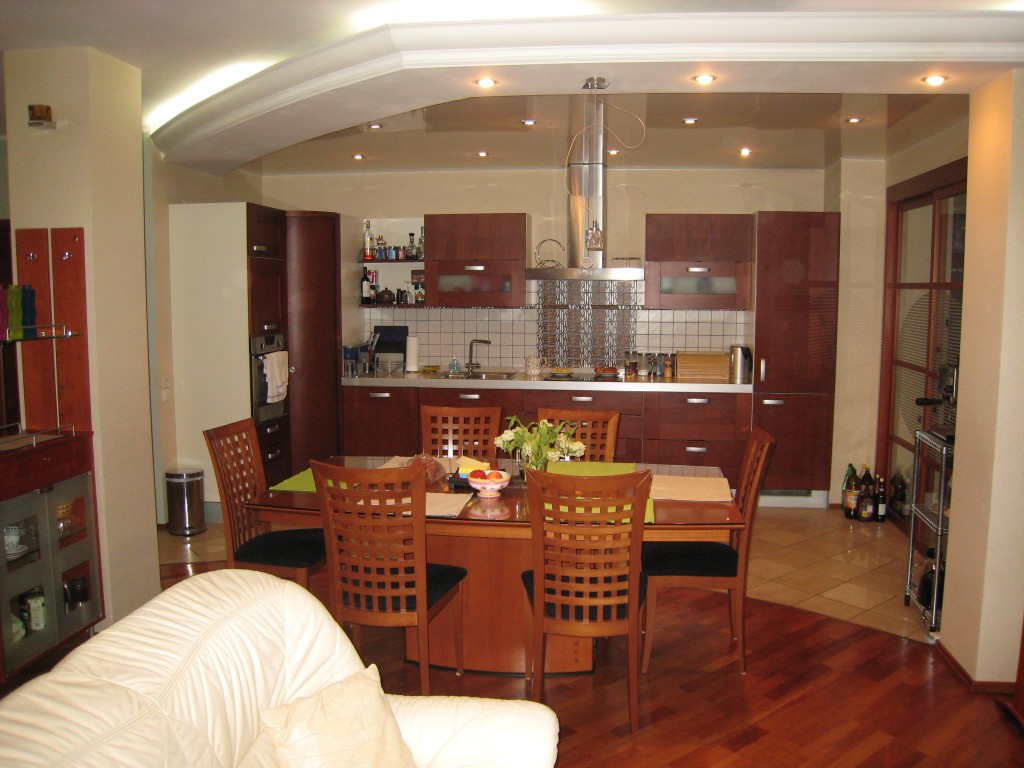
Zoning using differences in flow levels is one of the most common methods of zoning. Can be used hanging and stretch ceiling with a straight or rounded dividing line. You can emphasize the border with a line of built-in ceiling lights.
Podiums
Raising the work area onto the podium also helps to separate it from the rest of the space, regardless of the type of location. Such kitchen and dining room projects
must be developed by specialists, because it is necessary to ensure not only the reliability of the podium, but also accessibility for inspection and repair of the utilities located underneath it.
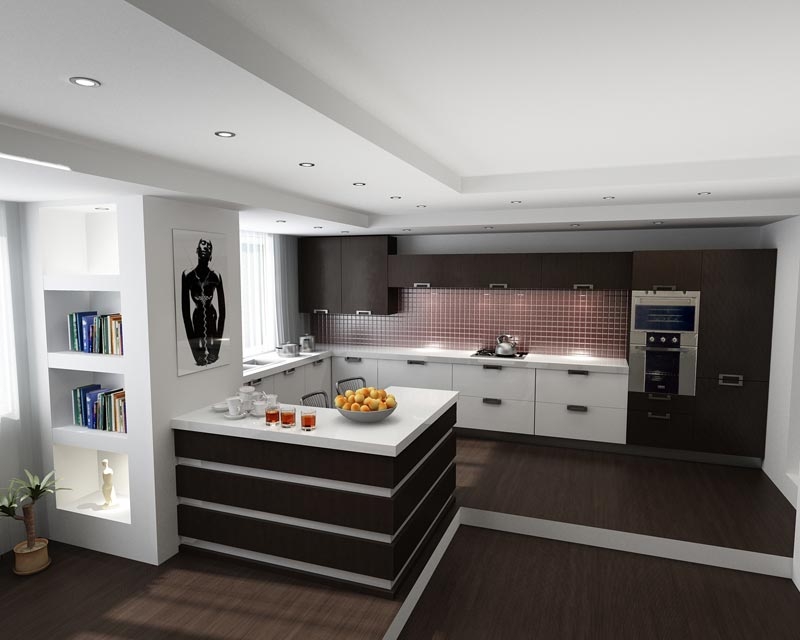
Dividing space with color
Zoning with color is the most effective method visual separation of sectors. To do this, similar in tone, harmonizing and contrasting combinations can be used, depending on the chosen style and size of the room. Bright colors and contrasts look organic in a large space, but visually “compress” them even more. small rooms. Finishing the kitchen-dining room small in size, it is preferable to use light shades that are similar in tone, or the use of different textures of the same color is becoming fashionable.
Color separation can be done on the ceiling, floor, walls separately (for example, the same color of the wall, but a sector of the floor of the work area highlighted in color, etc.) or in a combination of these elements.
Color separation can be effective using one piece of furniture, for example, a dark elongated table or bar counter in a bright room. It is only important to remember that the contrasting dividing element should not be lonely; such a striking accent needs support - wall shelf, panel frame or vase of identical color.
Lighting solutions
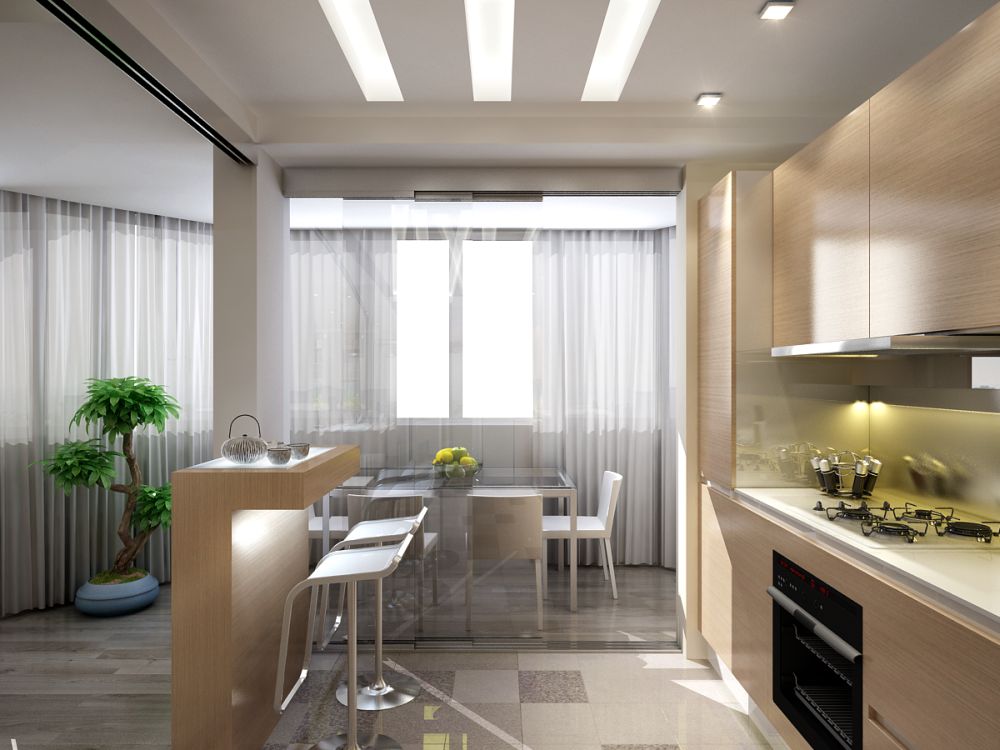
When talking about dividing the kitchen-dining room with light, most often the first thing that comes to mind is the contour arrangement of the lamps that form the boundary line. At the same time, the lighting of a combined room is more complex; it necessarily includes several elements located at different levels.
Central lighting
A distinctive feature of the dining room combined with the kitchen is the absence of overhead central lighting in the truest sense of the word. By placing a lamp or chandelier in the geometric center of the room, due to the large area of the space, you will leave the corners dark. In addition, with linear or corner layout in the working area, light from such a source will enter both the cooking sector and the dining sector not from above, but from the side. If the work area is located on an island, a chandelier above it will also be out of place.
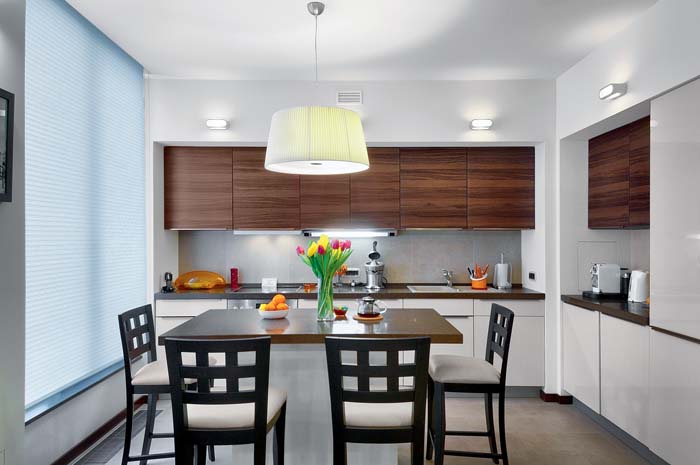
An analogue of central lighting can be used for a recreation area. The ceiling chandelier in this case is placed in the center of the section of the ceiling that is located above this sector, that is, offset from the general geometric center. Interesting solution will be the installation of a suspended glass ceiling with lighting above the seating area. Such ceilings provide even light and visually make the room more spacious and open. The surface of the ceiling can be evenly colored, have a pattern or a geometric pattern or a photograph (a popular option is to imitate the sky).
The work area is usually illuminated separately, and for these purposes it is better to use spotlights that provide uniform diffused light. Additionally, the cutting or serving table and stove are illuminated. If the zoning of space is carried out by a bar counter and ceiling lamps, their lines should repeat each other.
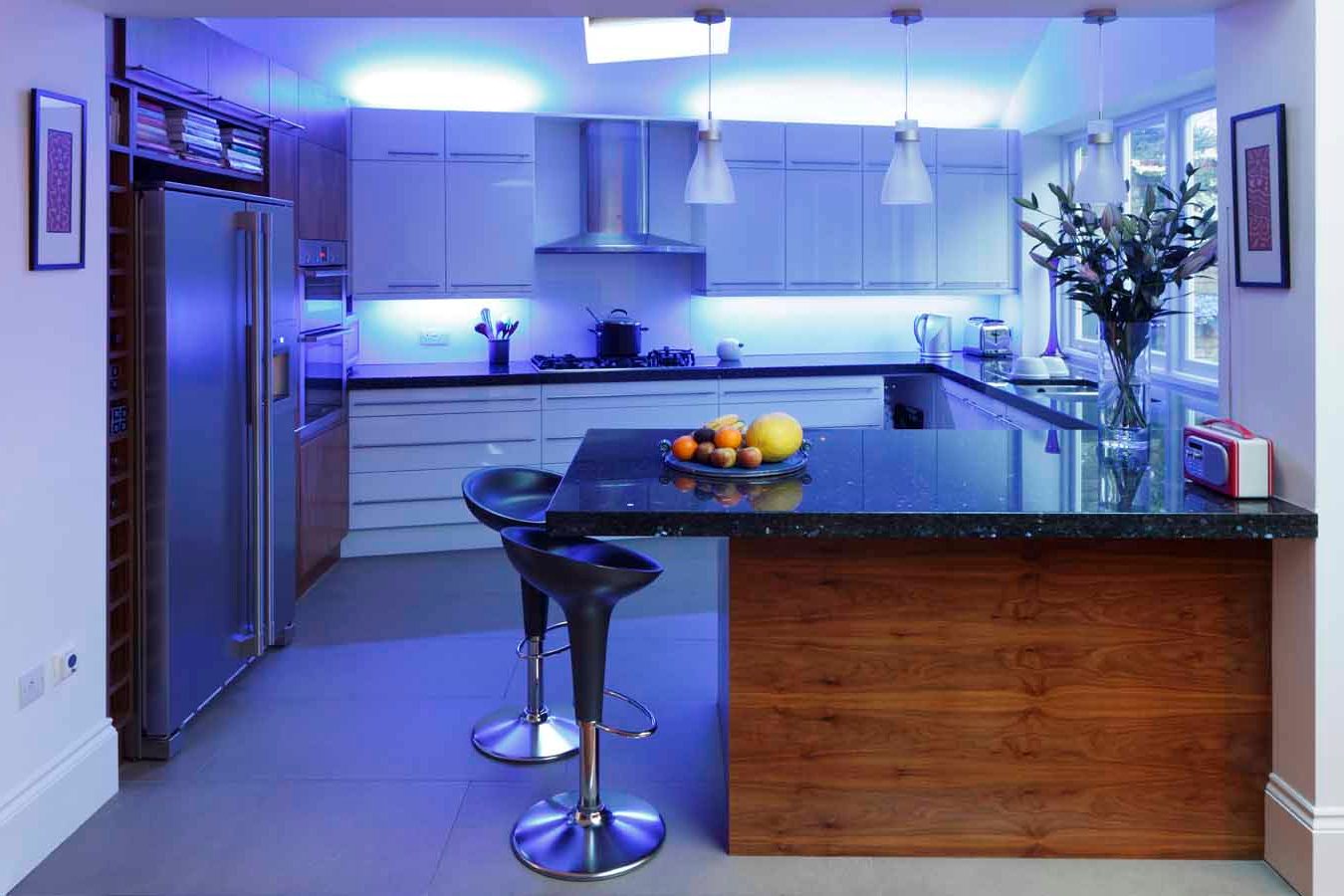
Often, for more effective zoning, in addition to the ceiling built-in lamps, wall lamps are installed, marking the boundaries of the sector or highlighting the arched structure.
Additional light sources
The kitchen and dining room will become comfortable and cozy when using light sources located at different levels. Floor-standing built-in models are not used very often, although with proper design they look stylish and original. But it is simply impossible to imagine a relaxation area without a sconce, floor lamp or table lamp. The shape and material of the lamps are selected in accordance with the design of the room. For techno or hi-tech style solutions, models with shiny nickel-plated surfaces are optimal. For classic interiors glass lamps with decor are suitable for rustic style– wicker or fabric lampshades.
Selection of household appliances
Household appliances and equipment for the kitchen-dining room work area require special attention. One of the main selection criteria is compactness and ergonomics, allowing you to reduce the area of the working sector, increasing the dining space. Moreover, such a restriction should not reduce the level of comfort; it should be convenient for the housewife to prepare food, serve dishes and wash dishes. The kitchen-dining room, equipped with built-in appliances, is functional and aesthetic. Everything is at hand in it and does not limit freedom of movement.
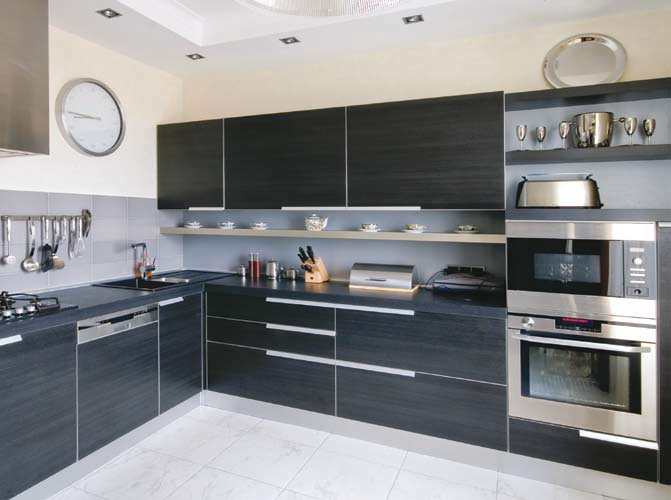
When combining rooms, placement in the kitchen washing machine undesirable.
- Firstly, it takes up quite a lot of space,
- Secondly, the noise of operating equipment will be heard in the dining area, which will interfere with relaxation, conversation or watching TV.
It is very important to choose a good hood for the kitchen-dining room. In this case, the aroma of the food will not be too rich and tiring. In addition, if unpleasant odors occur, they will disappear very quickly.
Compact household appliances(juicer, toaster, coffee maker or kettle, toaster, etc.) can be placed on the counter in order to make the workspace more free.
Furniture for kitchen-dining room
A well-furnished kitchen-dining room not only looks good, it is convenient both for cooking and for relaxing. The combination of comfort and functionality is the main selection criterion. Another important requirement for interior items is hygiene. This room is one of the most frequently visited. In addition, the possibility of minor troubles (spilled drinks, dropped plates of food, etc.) cannot be completely excluded. Therefore, all surfaces in the room must be easy to clean, moisture-resistant and well tolerate sanitary treatment using detergents. It is better to provide upholstered furniture (armchairs, sofas and even chairs) with removable and easily washable covers. This will help you easily keep the room clean, especially since for small rooms with a large number of interior items, it is recommended to choose light colors, and even small dirt is too noticeable on them.
The bar counter is an important element of the interior
When choosing furniture for the dining room or kitchen, do not forget about the bar counter. IN modern interiors combined premises, it has found wide application. This is not only fashionable, but also an incredibly comfortable element of the environment. Here are just a few advantages of using a bar counter in the kitchen-dining room:
With the help of a narrow and long surface it is easy to zone the space, regardless of the layout of the room. Depending on the location of the working sector and the design of the room, the bar counter can be straight, arched or curved (for example, in the form of a wave). For island or peninsular work areas, you can purchase a circular bar counter with an entrance opening. If two rooms are not completely combined, the bar counter can be folding and located in the arched opening connecting the rooms.
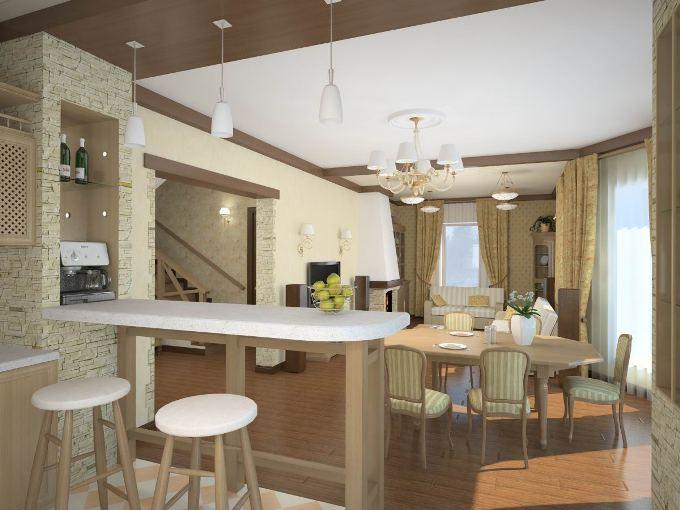
Using a bar counter to zone a combined space allows you to conveniently hide the sink, stove and other elements of the work area that do not add aesthetics to the room and visually clutter up the space.
It is convenient to drink tea, have breakfast or have a snack at the bar counter, if necessary, do this as quickly as possible. Thanks to this feature, bar counters in the interior of houses and apartments are often called breakfast counters.
Dining room sets
Dining room furniture for the kitchen is selected taking into account the area of the dining area. The classic solution is a round or rectangular table and comfortable chairs with backs. On sale you can find similar kits from different materials, so choosing models that match the interior will not be difficult. In an open space, it is permissible to use a fairly massive table with a tablecloth, smaller quantity free space, it is better to choose a table with a transparent glass top that will not look bulky.
For the tightest combined spaces, you can choose a folding or folding table and replace the chairs with stools that are stacked on top of each other, gathering into a kind of pyramid when not in use.
Design nuances
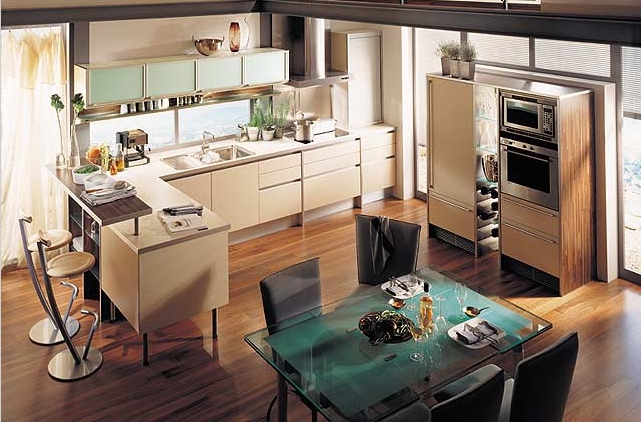
When developing the design of a kitchen-dining room, some techniques can visually adjust the room.
- The diagonal arrangement of flooring elements not only makes the room more spacious, but can also neutralize the excessive elongation of the room.
- Glossy surfaces that reflect light are preferable in cases where the space in the room is too small.
- Glass countertops look good in tight spaces, but it is best to limit the amount of glass in cabinet doors. Dishes, spices, and utensils visible through them represent many small elements in the overall visual perception of space, cluttering it and tiring the eye.
- You can “raise” ceilings using a variety of, sometimes very unexpected, vertical elements: a pattern or ornament on the wall, narrow corner cabinets, lines of wall-mounted built-in lamps, hanging plants, stripes on curtains, etc.
Do-it-yourself repairs and professional services
The kitchen-dining room will become a favorite room in your home if you carefully think through all the stages when arranging it - from layout to choosing equipment and interior items. This approach will make it comfortable and cozy, use it for family vacations and for receiving guests.
Often, when wanting to carry out such a redevelopment, the question arises: is it possible to do everything on your own, or is professional help a necessity? In most cases, the answer depends on the complexity of the repair. It is impossible to do without the help of specialists if it is necessary to move a gas stove and sink and the associated redevelopment of utilities. Experience and skills will be required to work with some modern finishing materials, For example, ceramic tiles large format. Partial combination of rooms using an arch and some types of finishing work can be done independently.
At the same time, it should be borne in mind that a professional kitchen-dining room design project will allow you to make the most efficient use of space by placing a large number of elements and avoiding the effect of clutter.
Design with appetite
Not everyone has the opportunity to set aside a home dining room separate room, but this is not really necessary. The dining area can be located in the kitchen or living room, as well as in a combined room (kitchen-living-dining room). At the same time, the dining area not only does not interfere, but even decorates the interior, if, of course, it is successfully decorated. Kitchens and living rooms look more cozy and homely if they have a dining table.
The dining area or mini-dining room is usually separated from the general space. In other words, zone the living room or kitchen so that the dining area does not merge with the work area in the kitchen and the sofa area in the living room. Firstly, it organizes the room. Secondly, it makes the dining area more cozy and comfortable, since it is perceived as separate, “isolated”.
The dining area needs to not only be highlighted, but also decorated. The main task is to make this area cozy and appetizing. Sitting at the dinner table should be pleasant, joyful and, of course, comfortable. The design of a dining room in a kitchen or living room is aimed at solving these problems.
Design of a kitchen-dining room or living-dining room: how to highlight the dining area?
If there is sufficient quantity square meters you can erect a light partition separating the mini-dining room from the rest of the space. A sofa with a high back, or an island in the kitchen can act as a partition or “separator”.
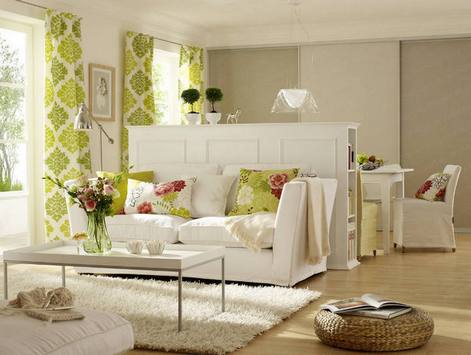
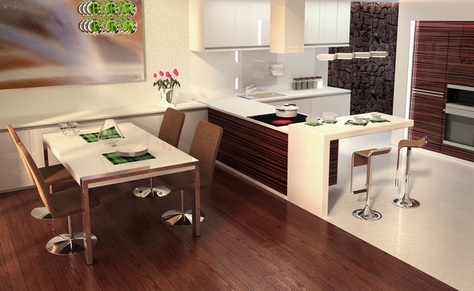
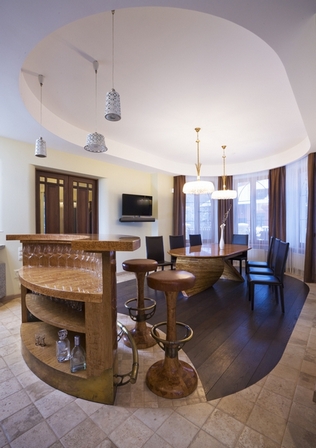
Regardless of the presence of such a “separator,” they try to highlight the dining area with decoration, combining it with the main one.
Dining area design: highlighting with finishing
Most often, a mini-dining room is distinguished by the decoration of the wall near which it is located. That is, they create a so-called “accent wall”. At the same time, they operate with contrasts, using either a very bright color or a spectacular material.
A section of the wall in the dining area can be covered with accent wallpaper, tiled, lined with stone or. This could be cork, laminate, mosaic, etc.
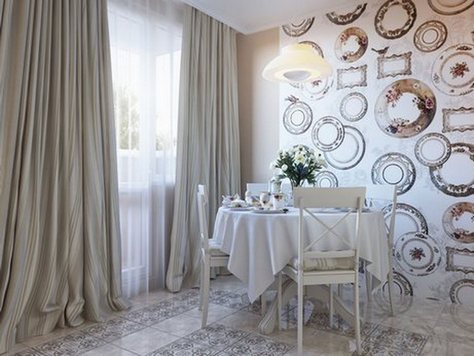
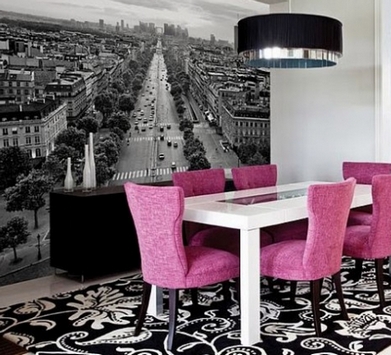
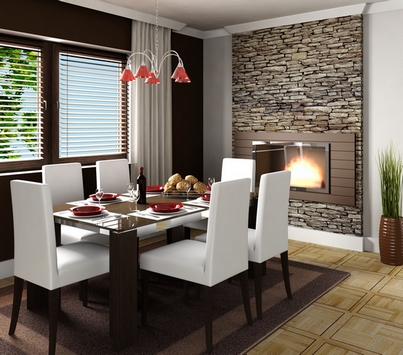
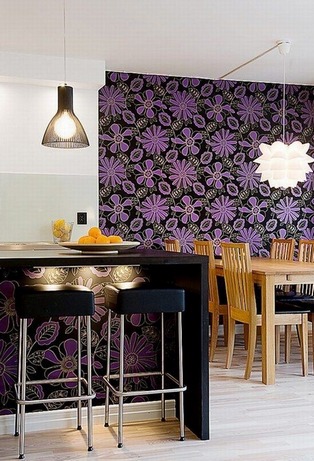
How to highlight dining area? Finishing!
Which option should you choose? Of course, this depends on the room and the style prevailing in it. So, if the dining area is located in the kitchen, tiles will come in handy. But this option is not very suitable for the dining area in the living room.
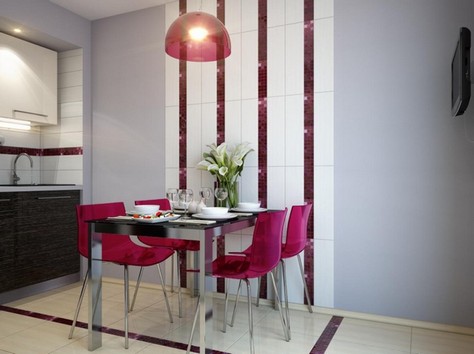
In the kitchen, the wall near the dining room can be covered with wallpaper with a gastronomic theme, but in the living room this will most likely be inappropriate.
But in the living-dining room there will be finishing with wooden panels, cork, wallpaper with floral patterns, photo wallpaper, etc.
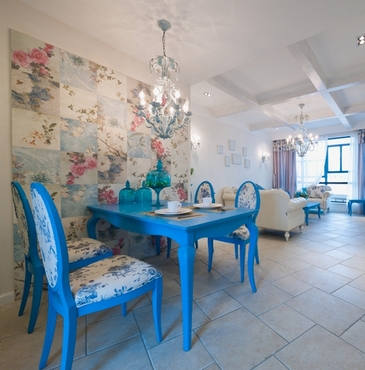
Zoning with finishing: highlighting the dining area
Interesting idea: finishing a section of wall in the dining area extending to the ceiling. This further isolates the mini-dining room, “isolating” it from the general space.
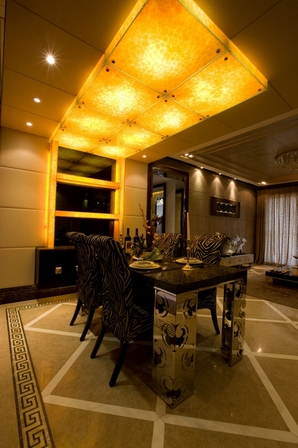
However, for zoning, only the ceiling can be used without including the walls. To do this, a ceiling structure is erected above the area where the table will be placed. Usually it follows the shape of the dining table top. It is equipped with lighting and pendant lamps.
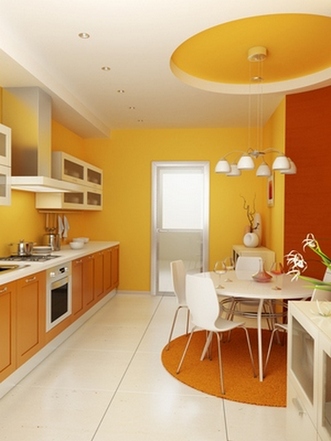
What designs are we talking about? This could be an additional tier of suspended ceiling, insertion of a suspended ceiling into a suspended ceiling, several short panels, or a panel fixed to the main ceiling, including stained glass or glass.
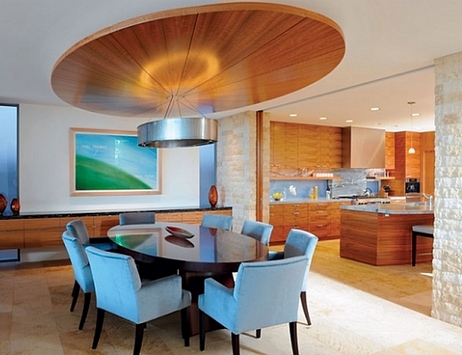
![]()
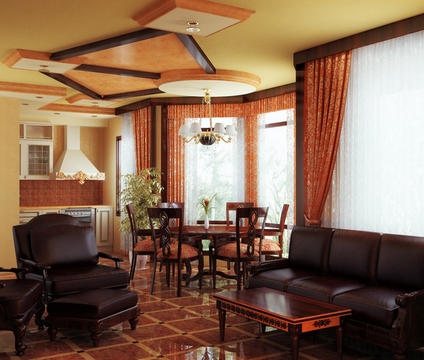
To highlight the dining area, not only the walls and ceiling, but also the floor are used. For this purpose, they use the technique of combining different floor coverings. For example, in the working area of the kitchen-dining room it is laid, and in the dining room - laminate or. This is a very popular technique that allows you not only to highlight zones, but also to add coziness to the part of the kitchen in which you do not cook, but eat food.
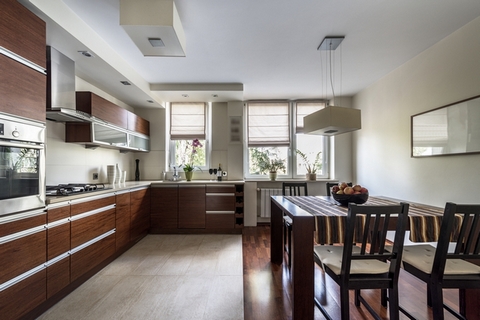
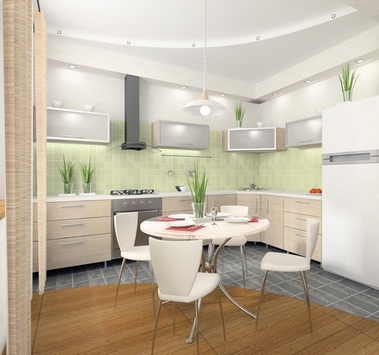
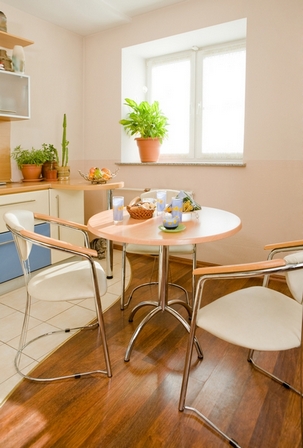
Highlighting the dining area by combining floor coverings
In kitchens and living rooms, a mini-dining room is highlighted as an accent flooring. So, for example, in the dining area located in the living room, it can be darker or, conversely, darker than in the entire room.
In the dining area, the floor can be decorated with the so-called “floor panel”. It is usually made from tiles or parquet. Even in small kitchen such a “panel” will clearly mark the dining area and decorate the entire room as a whole. This may not be a panel as such, but just an accent fragment made of tiles, laminate or parquet of a different color (for example, if black tiles are laid in the kitchen, a rectangle of black and white tiles can be laid in the dining area).
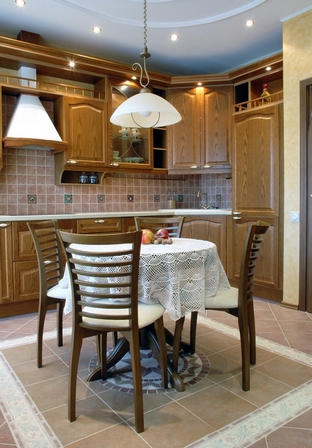
The living room will have a mini-dining room and a carpet on the floor. An attractive solution is a carpet that follows the shape of the tabletop.
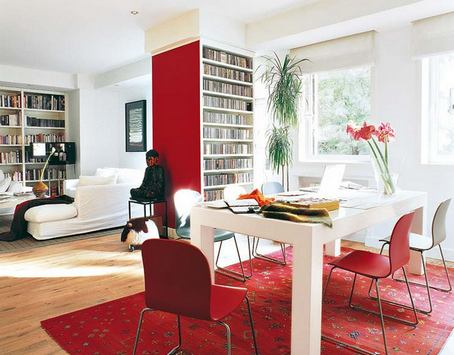
Placing the dining area in niches, corners, bay windows
It is, of course, inconvenient to dine in a deep room. A small recess in which the table is installed will allow you to effectively zone the space without creating inconvenience. A shallow niche can represent a wall structure or space between pieces of furniture.
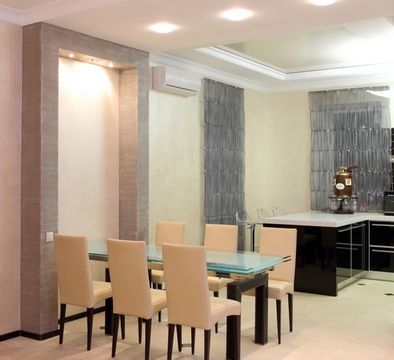
You can create a kind of niche or bay window near the window opening by arranging a seat under the window (you will have to remove the window sill). On the sides of the window you can install cabinets or cupboards that will limit this area.
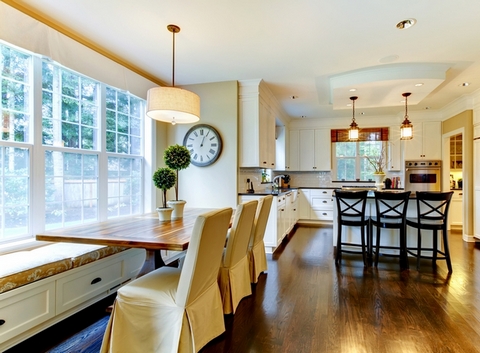
If the layout of the living room or kitchen includes a bay window, they try to organize the dining area in this place. The mini dining room in the bay window turns out to be extremely cozy and even romantic.
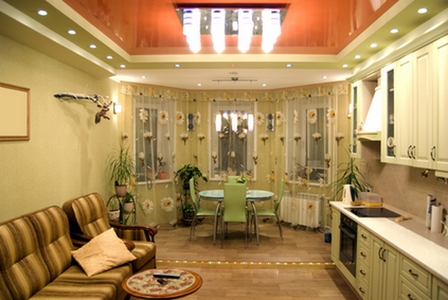
The same isolation effect can be achieved by setting up a dining area in the corner. To create a cozy “nook”, the dining corner can be limited: on one side by a wall, and on the other by a light structure or piece of furniture. Dining corners are often not very comfortable, but they are amazingly cozy. This option is suitable for small families.
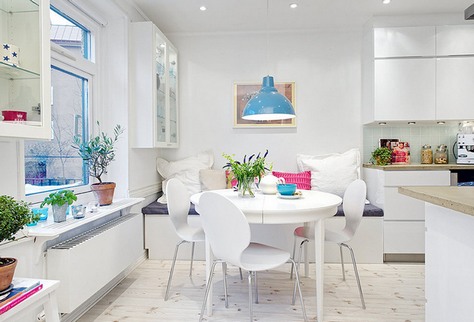
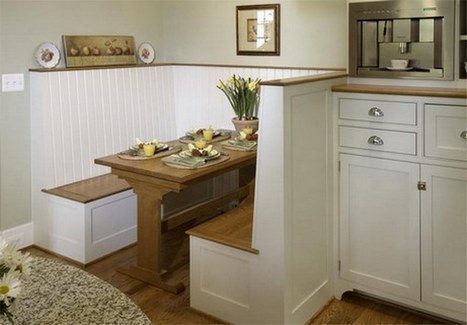
Highlighting the dining area with lighting
Wherever the dining table is located, a separate lamp or even several must be mounted above it. If there is a chandelier hanging in the center of the living room, then in the corner, above the dining table, you need to place another chandelier or a modest lampshade.
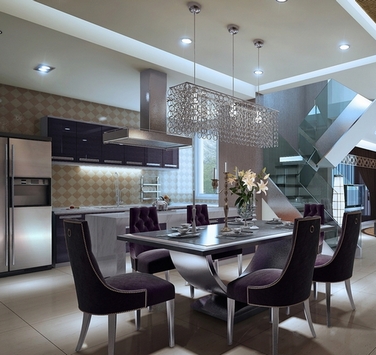
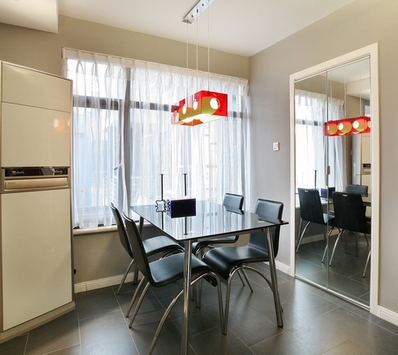
However, you can get by - in this case it is better to choose a so-called “arched” floor lamp that will illuminate the table from above. A table lamp will make the dining area even more cozy.
The dining room can also be illuminated by those built into the ceiling or in ceiling structure Spotlights.
If a dining table separates the kitchen and living room areas in a common “studio” room, a group of lamps is placed above it. It turns out to be a kind of “light curtain”, effectively delimiting the areas.
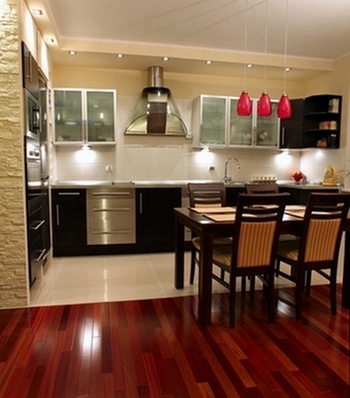
Dining area decor
The wall near which the dining table is located is decorated with paintings or posters. Still lifes look great in the kitchen: images of coffee cups, cakes, vegetables, fruits, etc. In the living room you can hang, for example, a city landscape depicting a street cafe or an abstraction.









